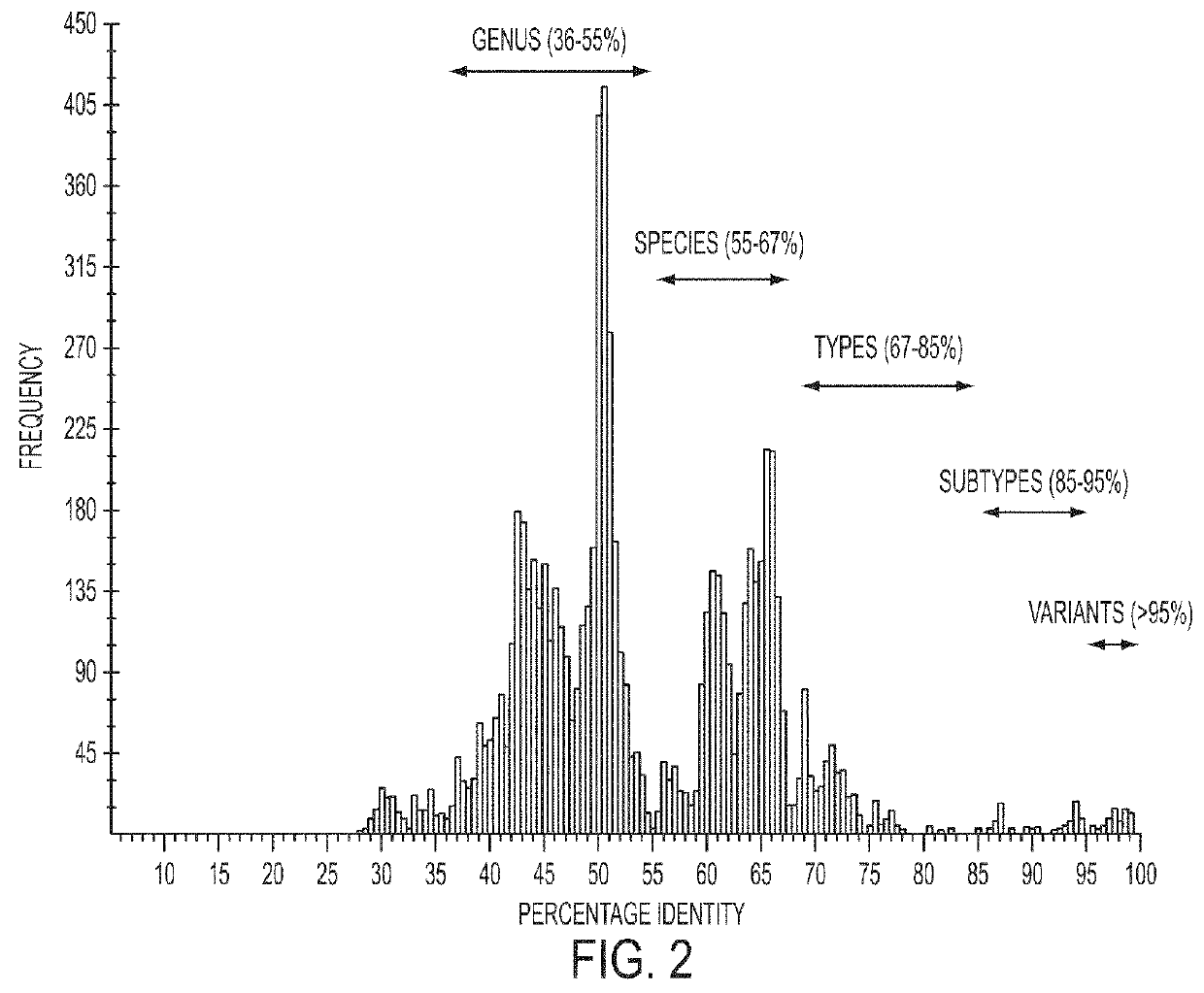Porcine torque teno virus vaccines and diagnosis
a technology of ttv and vaccine, which is applied in the field of ttv vaccine and diagnosis, can solve the problems of inability to prove a significant role, inability to demonstrate a significant role, and inability to demonstrate that ttvs play a significant role in the pathogenesis of specific swine diseases
- Summary
- Abstract
- Description
- Claims
- Application Information
AI Technical Summary
Benefits of technology
Problems solved by technology
Method used
Image
Examples
example 1
Viral DNA Extraction, Nested PCR and Genomic PCR
[0183]Convenient serum and semen samples from 20 conventional adult boars from a Virginia pig farm were used in the study. Total DNA was isolated from 20 serum and 19 semen samples using QIAamp DNA mini kit (Qiagen). To screen for the positive PTTV-containing samples, nested PCR amplifications of the conserved regions in the UTR of PTTV1 and PTTV2 were initially performed by using AmpliTag Gold polymerase (Applied Biosystems). The two primer pairs used to amplify the fragment A of PTTV1 were TTV1-mF (SEQ ID NO:45) / TTV1-mR (SEQ ID NO:46) (for the first-round PCR) and TTV1-nF (SEQ ID NO:47) / TTV1-nR. (SEQ ID NO:48) (for the second-round PCR), whereas the two primer pairs used to amplify the fragment D of PTTV2 were TTV2-mF (SEQ ID NO:49) / TTV2-mR (SEQ ID NO:50) (for the first-round PCR) and TTV2-nF (SEQ ID NO:51) / TTV2-nR (SEQ ID NO:52) (for the second-round PCR; FIG. 1A and Table 1).
[0184]In order to amplify the full-length genomic sequenc...
example 2
Screening for Porcine TTV Positive Samples Collected from Boars in a Farm from Virginia
[0185]Porcine TTV DNA was previously detected from pigs in different geographic regions by nested-PCR based on the UTR sequence of a Japanese PTTV1 strain Sd-TTV31 (McKeown et al., 2004, supra). With the recent identification of PTTV2, two different sets of nested-PCR primers have been used to amplify region A of PTTV1 and region D of PTTV2, respectively (FIG. 1A) (Ellis et al., 2008, supra; Kekarainen, T., Sibila, M., and Segales, J. (2006). Prevalence of swine Torque teno virus in post-weaning multisystemic wasting syndrome (PMWS)-affected and non-PMWS-affected pigs in Spain. J Gen Virol 87(Pt 4), 833-7; Krakowka et al., 2008, supra). A similar detection approach was also utilized in the present study to identify PTTV strains from pigs in the United States. In order to screen for indigenous PTTV1- or PTTV2-positive samples for subsequent use to determine the full-length genomic sequences, 20 ser...
example 3
Sequence and Phylogenetic Analyses
[0186]Generic analyses and alignment of DNA and amino acid sequences were performed using Lasergene package (DNASTAR Inc., Madison, Wis.). The genomic sequences of three known PTTV strains and their corresponding GenBank accession numbers used for the alignment and comparison are Sd-TTV31 (AB076001), TTV-1p (AY823990) and TTV-2p (AY823991). Pairwise sequence comparisons (PASC) were performed using 121 full-length genomic sequences of human and animal TTV-related strains available in GenBank with an online program PASC (http: / / www.ncbi.nlm.nih.gov / sutils / pasc / viridty.cgi?textpage=overview) (Bao et al., 2008).
[0187]Phylogenetic trees were constructed by the neighbor-joining method in the PAUP 4.0 program (David Swofford, Smithsonian Institute, Washington, D.C., distributed by Sinauer Associate Inc.) based upon the full-length genomic sequences and the deduced amino acid sequences of 4 ORFs of seven PTTV strains. The data were obtained from 1000 re-sam...
PUM
| Property | Measurement | Unit |
|---|---|---|
| Tm | aaaaa | aaaaa |
| temperature | aaaaa | aaaaa |
| volume | aaaaa | aaaaa |
Abstract
Description
Claims
Application Information
 Login to View More
Login to View More - R&D
- Intellectual Property
- Life Sciences
- Materials
- Tech Scout
- Unparalleled Data Quality
- Higher Quality Content
- 60% Fewer Hallucinations
Browse by: Latest US Patents, China's latest patents, Technical Efficacy Thesaurus, Application Domain, Technology Topic, Popular Technical Reports.
© 2025 PatSnap. All rights reserved.Legal|Privacy policy|Modern Slavery Act Transparency Statement|Sitemap|About US| Contact US: help@patsnap.com



